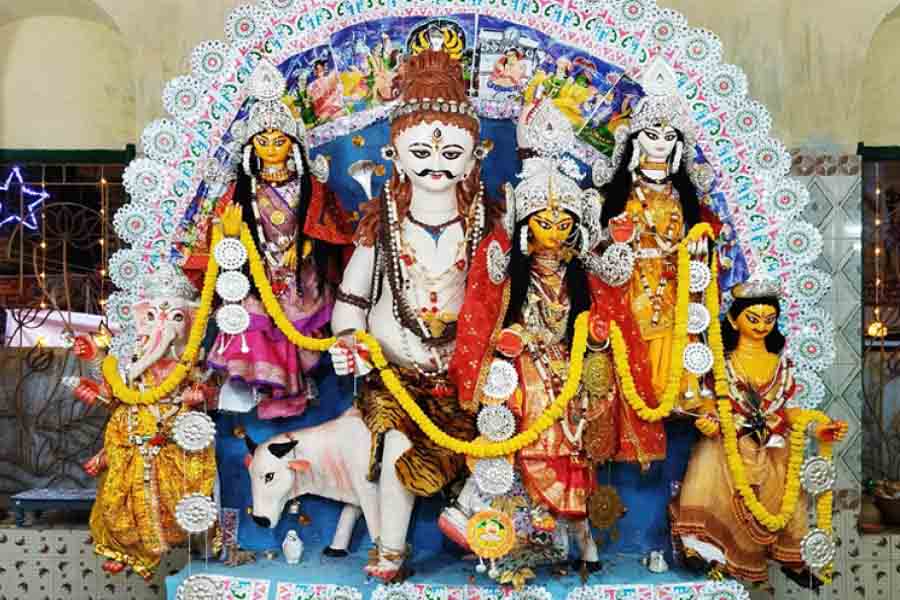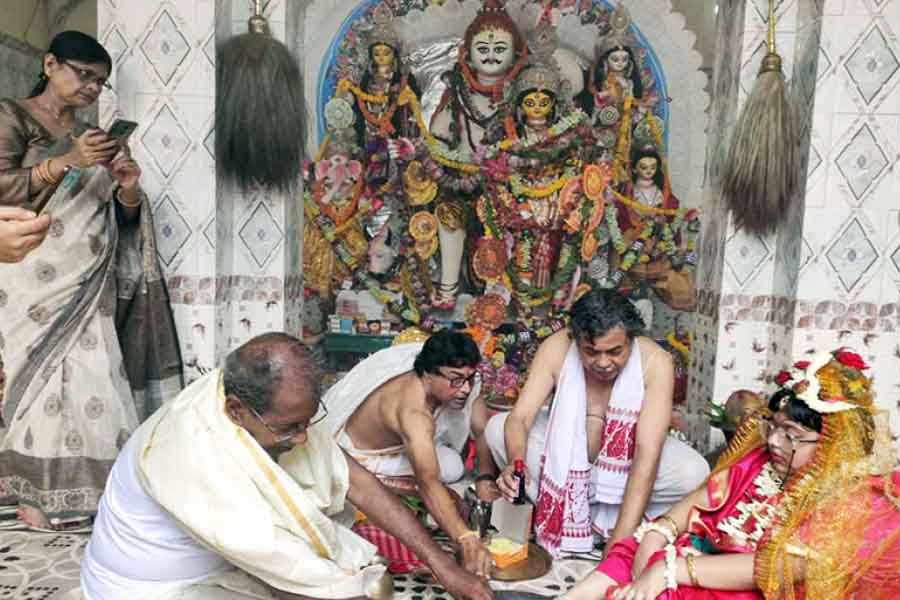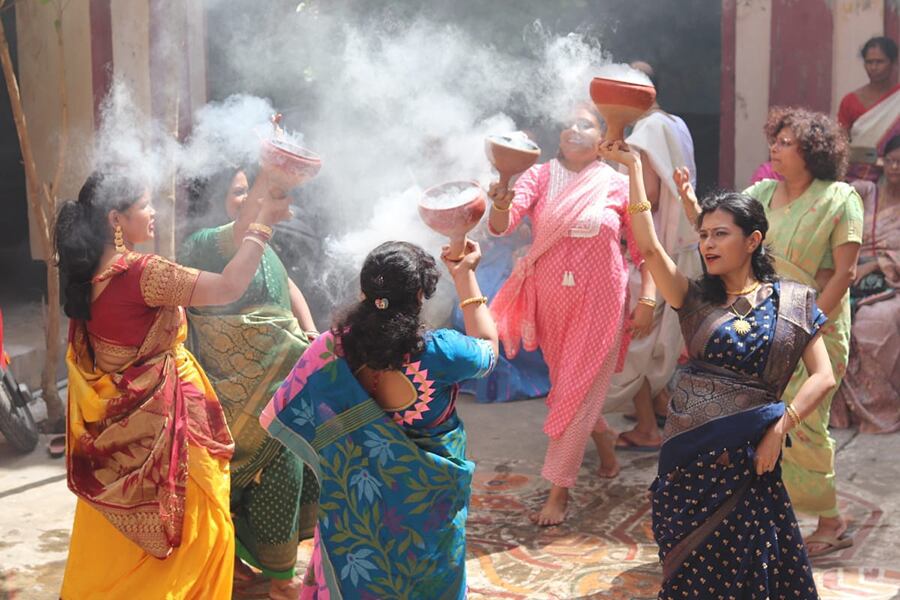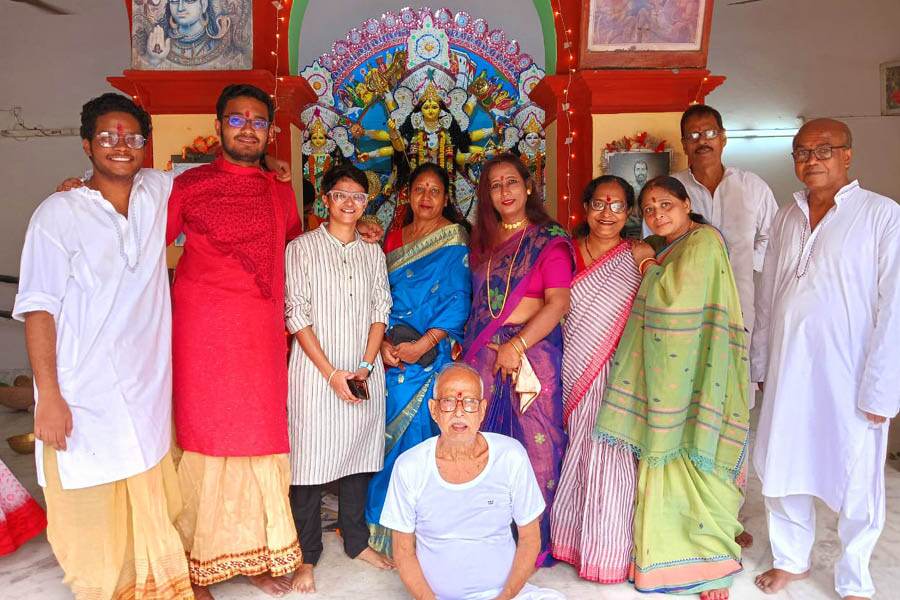A stronghold of the Dutch centuries ago, Chinsurah is an old town in Hooghly district, which even today bears signs of the era in architecture scattered across town. These include old mansions of families who have a history going back hundreds of years.
Several such mansions also have their own Durga Pujas, and one such is the Adhya Bari, which is celebrating the 290th year of the family Puja. The Adhya family has ancestral roots in Hooghly district’s Adisaptagram and later moved to Chinsurah. The family members were into various kinds of business, with one exception — Yogendralal Adhya or Yagu Master.
The first railway in Bengal ran on August 15, 1854, from Howrah to Hooghly. At that time, the station master at Hooghly station was Yogendralal Adhya, popularly known as Yagu Master courtesy of his job. In fact, he was such a popular figure of the time that his name features in a popular Bengali folk rhyme, which goes like this:
Aaikom Baikom Taratari
Yadu Master SashurBari
Rail Kom, Jhama Jham
Paa Pichle Alur Dom
It is difficult to have a literal translation of this chhora, which is a comic rendition of events wherein Yadu Master rushes to catch a train to travel to meet his in-laws and in the process slips and has a big fall.

Old photographs of Durga Puja at Adhya Bari
Yadu Master or Yogendralal was the grandson of Badan Chandra Adhya, who was one of the prominent personalities behind the establishment of Chinsurah as a business centre. It was also Badan Chandra who started the Durga Puja in this family. Today the descendants of Yogendralal’s seven sons have been continuing the family puja. The seven houses of these seven brothers continue to exist near the family’s thakurbari where Durga Puja is celebrated with great pomp and show.
The beginnings
Gold merchant or subarna banik Badan Chandra Adhya was the progenitor of the Adhya family. He built a beautiful three-arched thakur dalan at Panchanantala area of Chinsurah and started the Durga Puja at this thakur dalan. The celebrations grew in scale from the time of Yogendralal Adhya.
For the Adhya family, Durga Puja begins on the day of Rath Yatra with the Kathami Puja and the start of crafting the idol. The artisans who have been making the idol of the deity have been doing so for generations. Not only them, but many of those who facilitate the Adhya family’s Durga Puja like the priest who conducts the rituals and the cook who prepares sweets have been a part of the Puja for generations. According to a senior member of the family, Sankar Adhya, after a temporary break, this year’s Puja will be conducted by descendants of the family of priests who were part of the first generations of the Durgotsav.

The goddess is worshipped along with Shiva as Hara Gauri
While the kathamo begins on the day of Rath Yatra, the ritual of the bodhon of the goddess takes place on Pratipada, the day after Mahalaya. While Chandipath — chants to worship the warrior goddess — begin on Pratipada as well, the puja rituals follow the family’s Vaishnav traditions. The kul devta or family god of Adhya Bari is Sri Sri Shyamrai Jiu — a form of Radha-Krishna. The deity was consecrated in the house around 1730, and the festivals of Dol, Raash Yatra and Janmashtami are held with aplomb every year at the ancestral house.
Family traditions

A giant umbrella with a silver handle is carried by a family member who accompanies the nabapatrika to Sandeswartala Ghat
Like with most subarna banik households, Durga is worshipped as Mahishasurmadini at the Adhya Bari, except the idol is a two-handed deity seated peacefully on the lap of Shiva in Abhaya Mudra, and without any weapons. The goddess is worshipped in the form of Hara Gauri with Shiva and her children.
The family’s idol is adorned with gold and silver heirloom jewellery, and decked in the famous daaker saaj, with multicoloured foil or rangta and silver sequins. For a short while, the family used a decor of white shola but the dakar shaaj wasFor a small duration, the décor used to be of Shola, but then Daker Saaj has again been adopted. The weapons and accessories carried by goddess Durga’s family, including Shiva’s damru are made of silver and have been used by the family for decades.
Rituals like the nabapatrika snan take place at the nearby Sandeswartala Ghat. A giant umbrella with a silver handle is carried by a family member who accompanies the nabapatrika.

Kumari Puja is performed on Navami at Adhya Bari
A festive feast for the goddess
The food offerings made to the goddess are a grand affair at Adhya Bari. The vien or preparation of confections is completed almost a week before Puja and all the cooking is done by a cook who travels from Bhadrak in Odisha. The womenfolk of the house also join in the preparations.
Traditionally no annabhog or bhog with rice is offered to the deity, and the main food offerings include luchi, radhaballavi, five types of fried vegetables, halwa, payesh, padma nimki — fried savoury snacks in the shape of lotuses — and various types of naru including narkel naru (coconut), muger naru (moong dal) chunor naru (barley) and several type of seasonal Bengali sweets like peraki, changari, and jobe goja. The indigenously prepared sweets are enormous in size and plenty in numbers. On Ashtami, a naivedya of a maund of rice (approximately 37kg) is offered to the goddess.

On Sandhi Puja, male members of the family light 108 lamps
On Sandhi Puja, male members of the family light 108 diyas. Earlier, guns were fired during Sandhi Puja, however, the practice has now stopped. A family ritual of dhuno porano or lighting up incense in a dhuno takes place after Sandhi Puja and after the puja on Navami, mentions Sankar Adhya. Navami is also when Kumari Puja and a hom yagna are held at Adhya Bari.
A traditional farewell

Women of Adhya Bari dancing with 'dhunuchis' on Bijoya Dasami.
On Dashami, after the symbolic Darpan Visarjan, family members have a meal of rice and fish before performing the rituals of Devi Boron and kanakanjali. Members of the present generation of the family also perform a dhunuchi naach in front of the goddess on this day, which is followed by the Sindur Khela.
The goddess’ idol is then carried to Sandeswartala Ghat for immersion. After the immersion, all the members of Adhya Bari meet at their house and the priest sprinkles holy water on their heads after which Bijoya is celebrated with sweets, hugs, and seeking the blessings of the elders of the family.


